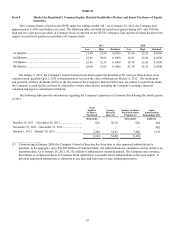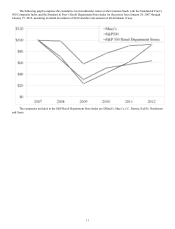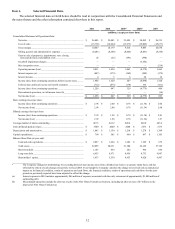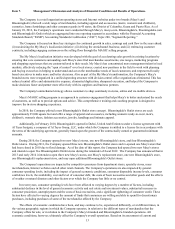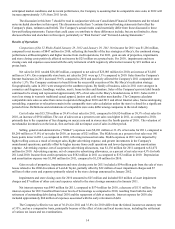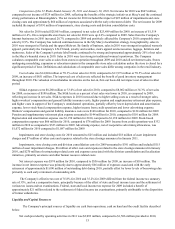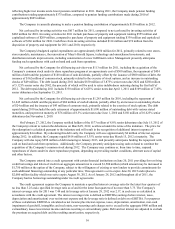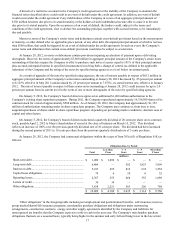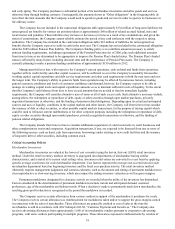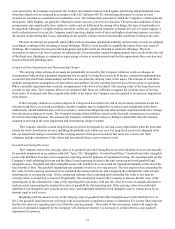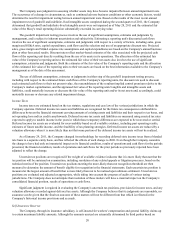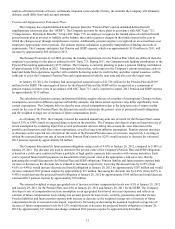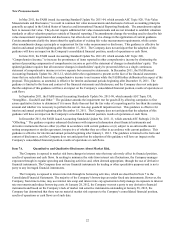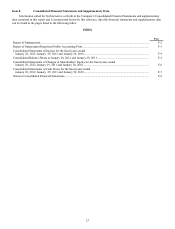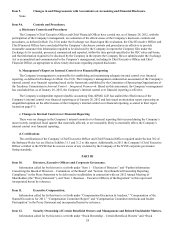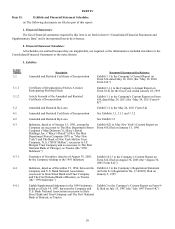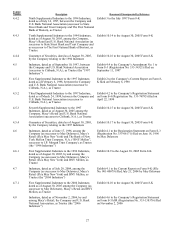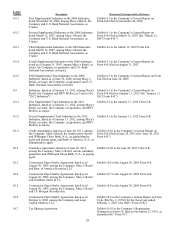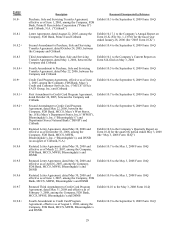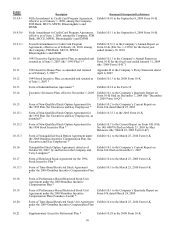Macy's 2011 Annual Report Download - page 26
Download and view the complete annual report
Please find page 26 of the 2011 Macy's annual report below. You can navigate through the pages in the report by either clicking on the pages listed below, or by using the keyword search tool below to find specific information within the annual report.20
The Company uses judgment in assessing whether assets may have become impaired between annual impairment tests.
The occurrence of a change in circumstances, such as continued adverse business conditions or other economic factors, would
determine the need for impairment testing between annual impairment tests. Based on the results of the most recent annual
impairment test of goodwill and indefinite-lived intangible assets completed during the second quarter of 2011, the Company
determined that goodwill and indefinite-lived intangible assets were not impaired as of May 28, 2011 and the estimated fair
value of the Macy's retail operating division substantially exceeded its carrying value.
The goodwill impairment testing process involves the use of significant assumptions, estimates and judgments by
management, and is subject to inherent uncertainties and subjectivity. Estimating a reporting unit's discounted cash flows
involves the use of significant assumptions, estimates and judgments with respect to a variety of factors, including sales, gross
margin and SG&A rates, capital expenditures, cash flows and the selection and use of an appropriate discount rate. Projected
sales, gross margin and SG&A expense rate assumptions and capital expenditures are based on the Company's annual business
plan or other forecasted results. Discount rates reflect market-based estimates of the risks associated with the projected cash
flows of the reporting unit directly resulting from the use of its assets in its operations. The allocation of the estimated fair
value of the Company's reporting units to the estimated fair value of their net assets also involves the use of significant
assumptions, estimates and judgments. Both the estimates of the fair value of the Company's reporting units and the allocation
of the estimated fair value of the reporting units to their net assets are based on the best information available to the Company's
management as of the date of the assessment.
The use of different assumptions, estimates or judgments in either step of the goodwill impairment testing process,
including with respect to the estimated future cash flows of the Company's reporting units, the discount rate used to discount
such estimated cash flows to their net present value, the reasonableness of the resultant implied control premium relative to the
Company's market capitalization, and the appraised fair value of the reporting units' tangible and intangible assets and
liabilities, could materially increase or decrease the fair value of the reporting unit and/or its net assets and, accordingly, could
materially increase or decrease any related impairment charge.
Income Taxes
Income taxes are estimated based on the tax statutes, regulations and case law of the various jurisdictions in which the
Company operates. Deferred income tax assets and liabilities are recognized for the future tax consequences attributable to
differences between the financial statement carrying amounts of existing assets and liabilities and their respective tax bases, and
net operating loss and tax credit carryforwards. Deferred income tax assets and liabilities are measured using enacted tax rates
expected to apply to taxable income in the years in which those temporary differences are expected to be recovered or settled.
Deferred income tax assets are evaluated for recoverability based on all available evidence, including past operating results,
estimates of future taxable income, and the feasibility of tax planning strategies. Deferred income tax assets are reduced by a
valuation allowance when it is more likely than not that some portion of the deferred income tax assets will not be realized.
As of January 29, 2011, the Company changed its methodology for recording deferred state income taxes from a blended
rate basis to a separate entity basis, and has reflected the effects of such change to 2008. Even though the Company considers
the change to have had only an immaterial impact on its financial condition, results of operations and cash flows for the periods
presented, the financial condition, results of operations and cash flows for the prior periods as previously reported have been
adjusted to reflect the change.
Uncertain tax positions are recognized if the weight of available evidence indicates that it is more likely than not that the
tax position will be sustained on examination, including resolution of any related appeals or litigation processes, based on the
technical merits of the position. Uncertain tax positions meeting the more-likely-than-not recognition threshold are then
measured to determine the amount of benefit eligible for recognition in the financial statements. Each uncertain tax position is
measured at the largest amount of benefit that is more likely than not to be realized upon ultimate settlement. Uncertain tax
positions are evaluated and adjusted as appropriate, while taking into account the progress of audits of various taxing
jurisdictions. The Company does not anticipate that resolution of these matters will have a material impact on the Company's
consolidated financial position, results of operations or cash flows.
Significant judgment is required in evaluating the Company's uncertain tax positions, provision for income taxes, and any
valuation allowance recorded against deferred tax assets. Although the Company believes that its judgments are reasonable, no
assurance can be given that the final tax outcome of these matters will not be different from that which is reflected in the
Company's historical income provisions and accruals.
Self-Insurance Reserves
The Company, through its insurance subsidiary, is self-insured for workers' compensation and general liability claims up
to certain maximum liability amounts. Although the amounts accrued are actuarially determined by third parties based on


